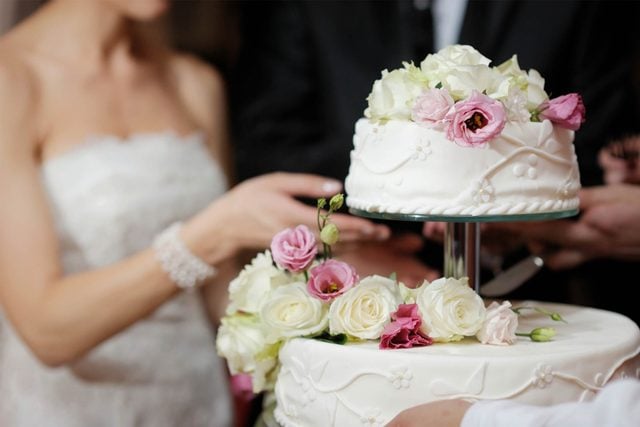The Hidden Secrets Behind the History of Wedding Cakes
Updated: Oct. 26, 2017
They weren't always just a tasty dessert.
 A wedding cake might be just as much a symbol of a marriage ceremony as the bride’s dress. Newlyweds didn’t always end their big day with confections covered in dainty frosting roses, though. The wedding cake tradition started with a less sugary—but equally sweet—origin.
A wedding cake might be just as much a symbol of a marriage ceremony as the bride’s dress. Newlyweds didn’t always end their big day with confections covered in dainty frosting roses, though. The wedding cake tradition started with a less sugary—but equally sweet—origin.
Wedding cakes have their roots in Ancient Rome, when marriage ceremonies ended with a scone-like wheat or barley cake broken over the bride’s head for luck and fertility. The new husband and wife would eat a few crumbs together as one of their first unified acts as a married couple, according to Gastronomica: The Journal of Critical Food Studies. Not quite the mouthful of frosting you’d get today, but close enough. Once the newlyweds had their share, wedding guests would scoop up the leftover crumbs for good luck. (Learn the unromantic reason we have bridesmaids and groomsmen.)
The Romans brought their bread-breaking wedding tradition with them when they conquered Britain in 43 CE. The Brits took the tradition one step further, throwing the bread at the bride to show her fertility, according to The Telegraph. (If you think that’s weird, check out the life-saving reason bridesmaids wear the same color.)
By the medieval days, the English stopped with the plain ol’ wheat cake and starting stacking spiced buns, scones, and cookies as high as possible—a precursor to the tiered cakes of today—and the bride and groom would try to kiss over it. Legend said if they smooched successfully without letting the whole thing topple over, they’d have good fortune. (Don’t miss these other lucky wedding traditions from around the world.) A French chef thought the pile of pastries was tacky and recommended creating a nice stack with pieces of broom handle, but the nice tiers wouldn’t catch on for a couple centuries.
The first known official wedding confection comes from a 1685 recipe for Bride’s Pye: pastry crust filled an assortment of oysters, lamb testicles, throat, rooster comb, and pine kernels. Delicious.
In Yorkshire, it was thought that eating the pie ensured the couple would have a happy life together, so declining a slice (even one filled with testicles and thyroid) was a major no-no. Single ladies certainly had incentive to eat their share, though. A ring was hidden somewhere in the pie, and whoever found it would be next in line to get married—sort of like the bouquet-throwing of weddings today. Here’s how the tradition of throwing bouquets got its start.
By the seventeenth century, wedding cakes started replacing bridal pies. Most homes didn’t have an oven, so bakers would bake two pastry crusts on the hearth, then put currants between them like a sandwich and sprinkle sugar on top.
Some couples waited until reaching their new home to dig into their wedding cakes. The bride would take a bite, then toss the rest over her head like a bouquet so that she and her new husband would get everything they want out of life. The groom did his part, too, by throwing a plate over his head. If it broke, they’d be destined for a happy marriage.
When refined sugar started getting more common and cheaper in England, a bright white icing became the topping of choice at weddings. For one thing, a pure white symbolized the bride’s virginity, but it also was a show of wealth, according to Smithsonian.com.
Supposedly, tiered cakes got their start in the late 18th century, when the apprentice of a London baker fell in love with his boss’s daughter. He wanted to create an elaborate cake to impress her when he proposed. (His sentiment was way sweeter than the unromantic origin of engagement rings.) Looking to the tiered spire of St. Bride’s Church, legend has it the apprentice baker recreated the look in pastry form.
The look stuck for a while, though now, of course, they’re making way for some creative Pinterest-inspired alternatives. Mini cupcakes? A sundae bar? The possibilities are endless.
For more eye-opening wedding facts, learn the real origin of the “something borrowed, something blue” tradition.
[Source: Brides]